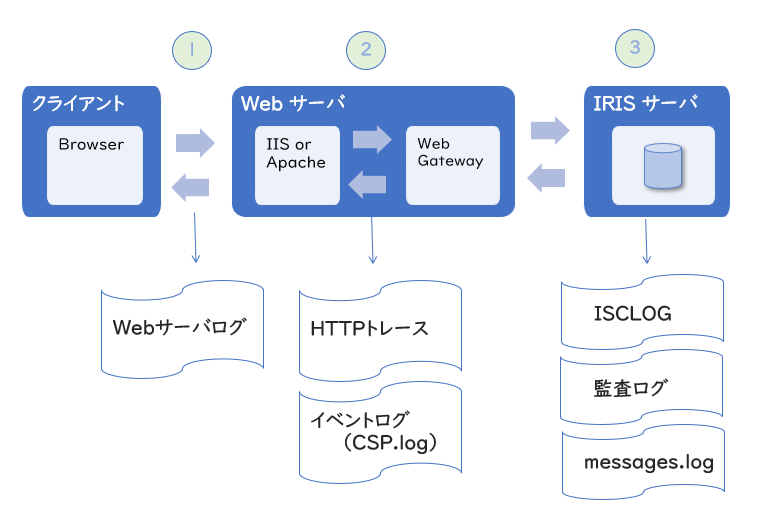こちらの記事では、RESTやCSPなどの「Webアプリケーションのトラブルシューティング」のヒントをご紹介します。
何かしらのトラブルと思われる事象が発生した場合、確認したいのがログファイルになります。
各コンポーネント間のやり取りで、どこでどのようなトラブルが発生しているかを、それぞれログを取得して確認することができます。
① クライアント ⇔ Webサーバ間では、「Webサーバログ(IISやApacheのアクセスログなど)」、
② Webサーバ ⇔ Webゲートウェイ間では、「イベントログ」・「HTTPトレース」、
③ Webゲートウェイ ⇔ IRISサーバ間では、「ISCLOG」・「監査ログ」・「messages.log」などがあります。

こちらの記事では、IRISで取得できるログとして  と
と  で取得可能なログの取得方法をご紹介します。
で取得可能なログの取得方法をご紹介します。
② Web サーバと Webゲートウェイ間のアクセスに関連するログ情報
◆ イベントログ
1) Webゲートウェイ管理ページ(http://<IPアドレス>:<ポート>/csp/bin/Systems/Module.cxw)に接続します。
2) イベントログを削除します。
[イベントログを参照] > ログをクリア をクリック
3) イベントログレベルを設定します。
[デフォルトパラメータ(Default Parameters)] > イベントログレベル(Event Log Level)に
イベントログレベル を設定し保存します(例:ev7)
4) エラーやトラブルとなっている事象を発生させます。
5) イベントログレベルを解除します。 ※ログの解除は忘れずに行うようにしてください。
[デフォルトパラメータ(Default Parameters)] > Event Log Level を消して保存します
◆ HTTPトレースログ
1) Webゲートウェイ管理ページ(http://<IPアドレス>:<ポート>/csp/bin/Systems/Module.cxw)に接続します。
2) HTTP トレースを表示(View HTTP Trace) をクリックします。
3) トレース ON をクリックします(HTTPトレースを開始します)
4) エラーやトラブルとなっている事象を発生させます。
5) トレース OFF をクリックします(HTTPトレースを終了します)
※トレースの解除は忘れずに行うようにしてください。
③ Webゲートウェイ と IRIS サーバ間のアクセスに関連するログ情報
◆ ISCLOG
ISCLOGの使用方法については、以下のFAQトピックをご覧ください。
CSP(REST)に関するトラブルシューティングに使用できるツールはありますか。
◆ 監査ログ
監査ログの使用方法については、以下のFAQトピックをご覧ください。
CSP/RESTアプリケーションに接続できません。どのように調査すれば良いですか?
管理ポータルに接続できる場合は、以下の方法で確認できます。
いつも使用しているユーザで IRIS や Caché にアクセスできなくなった時の原因の探り方(監査の使い方)
◆ messages.log
messages.log は、InterSystems IRIS のシステム管理者のディレクトリ (install-dir/mgr) にあります。
詳細は以下のドキュメントをご覧ください。
messages.log
【注意】
調査後、ログの解除を忘れずに行うようにしてください。
また、必要がない場合は収集したログのクリアも行うようにしてください。
ログの解除を忘れると、そのままログ情報を収集し続け、ディスク容量を圧迫することになりますのでご注意ください。
おまけ:
FHIRの場合は、別途取得できるログ情報があります。詳細は以下のドキュメントをご覧ください。
FHIR サーバのデバッグ
